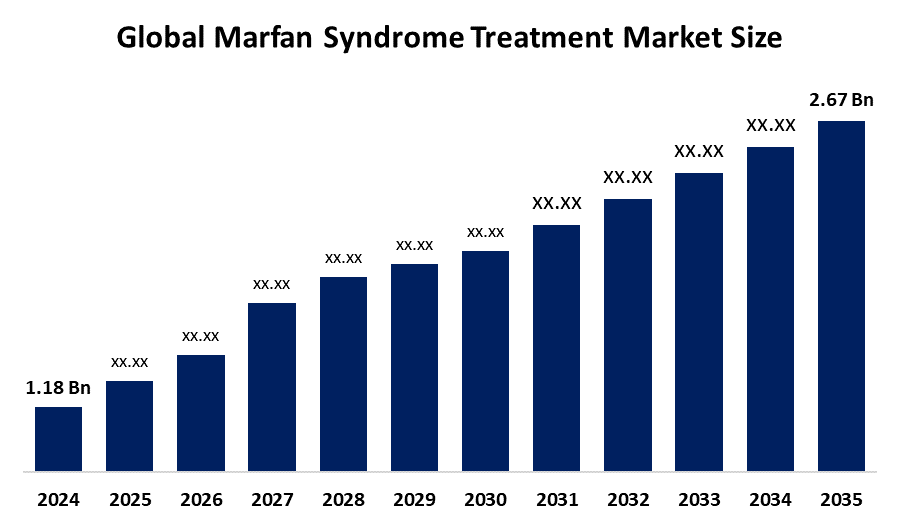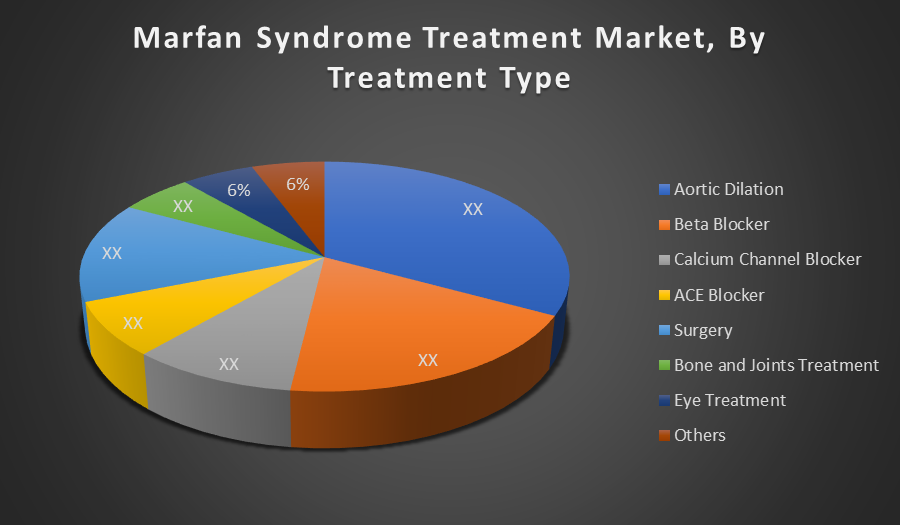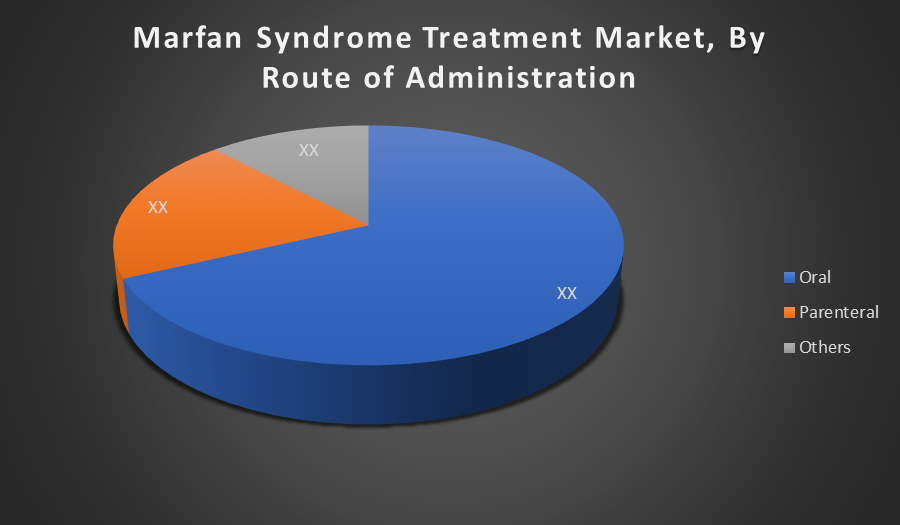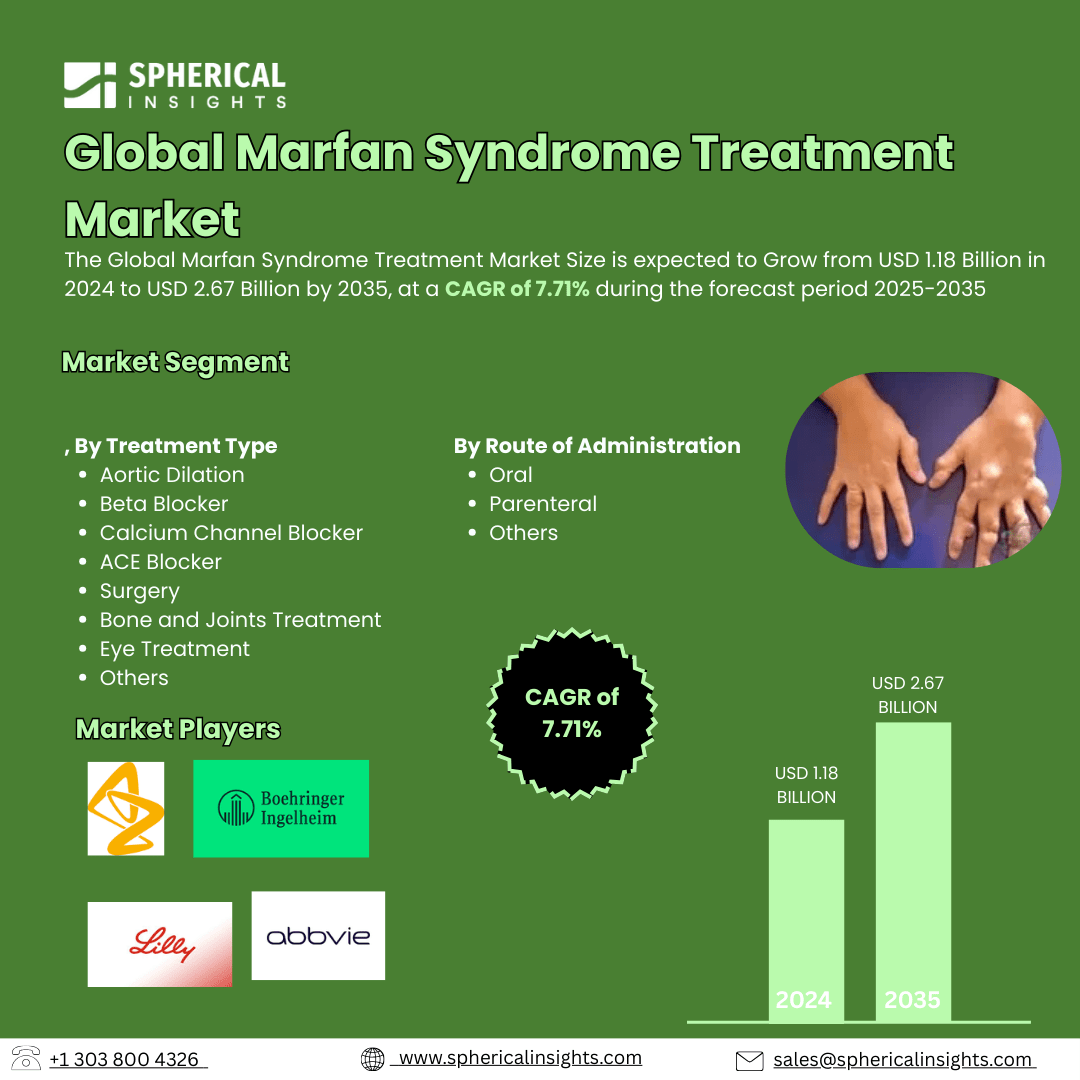- As per Spherical Insights & Consulting, The Global Marfan Syndrome Treatment Market Size is expected to Grow from USD 1.18 Billion in 2024 to USD 2.67 Billion by 2035, at a CAGR of 7.71% during the forecast period 2025-2035, owing to the launch of new therapies in the market and the rise in the number of cases.
- The leading Marfan Syndrome Treatment Market Companies such as AstraZeneca, Boehringer Ingelheim, Eli Lilly, AbbVie, Bayer, Pfizer, Takeda Pharmaceuticals, F. Hoffmann-La Roche, Amgen, Teva Pharmaceuticals, Sanofi, Novartis, Bristol-Myers Squibb, Merck & Co., GSK, and Others.

Marfan Syndrome Treatment Market: Understanding and Treatment Algorithm:
Marfan Syndrome is an inherited disorder of connective tissue due to FBN1 gene mutations. It occurs in the skeleton, eyes, cardiovascular system, and skin. Long limbs, hypermobile joints, and cardiac issues, especially those of the aorta, are common in affected persons. Early detection and treatment are necessary to avoid serious consequences.
Marfan Syndrome Diagnosis:
Diagnosis of Marfan Syndrome is made by a combination of clinical exams, family history, genetic testing, and imaging studies. Echocardiograms check for the size of the aorta and heart valves, and eye examinations identify lens dislocation. The updated Ghent criteria are most frequently used to establish the diagnosis from systemic features and genetic markers.
Marfan Syndrome Treatment:
Management is geared towards the prevention of complications and symptom control. Beta blockers or angiotensin receptor blockers reduce the workload on the aorta. Surgery for aortic aneurysms, routine cardiovascular checks, eye refraction, and orthopedic management are essential. Lifestyle changes and regular follow-ups are essential in enhancing long-term outcomes and quality of life.
Marfan Syndrome Treatment Epidemiology:
The disease epidemiology covered in the report provides historical as well as forecasted epidemiology segmented by Total Diagnosed Incident Population of Marfan Syndrome Treatment, Gender specific Diagnosed Incidence of Marfan Syndrome Treatment, Type specific Diagnosed Incidence of Marfan Syndrome Treatment, Age specific Diagnosed Incidence of Marfan Syndrome Treatment, Diagnosed Incident Population based on Primary Site of Marfan Syndrome Treatment, and Diagnosed Incident Population based on Histologic Classification of Marfan Syndrome Treatment Tumour in the global market covering North America, Europe, Asia-Pacific, Latin America, the Middle East, and Africa from 2024 to 2035.
Principal Insights:
This section offers a global overview of Marfan Syndrome treatment epidemiology in major markets worldwide.
Country Wise Marfan Syndrome Treatment Multiforme Epidemiology:
- The epidemiology segment provides Marfan Syndrome Treatment prevalence data and findings across key regions worldwide, including North America, Europe (Germany, France, Italy, Spain, and the United Kingdom), Asia-Pacific (including Japan), Latin America, the Middle East, and Africa.
Marfan Syndrome Treatment: Recent Developments:
- In May 2025, the European Medicines Agency announced the orphan drug designation of allopurinol for Marfan syndrome, marking it as the first drug granted this status for the condition. The decision acknowledged promising preclinical findings in preventing aortic aneurysm progression, and enabled incentives such as market exclusivity and regulatory support for clinical development.
Marfan Syndrome Treatment Marketed Drugs:
• Cozaar (Losartan): Merck & Co.
Cozaar (losartan) is an angiotensin II receptor blocker (ARB) used to reduce aortic root enlargement in patients with Marfan Syndrome. It helps decrease the pressure and stress on the aorta, lowering the risk of dissection. It is often used as an alternative or adjunct to beta-blockers.
• Atenolol: AstraZeneca
Atenolol is a beta-blocker that slows heart rate and reduces blood pressure, easing stress on the aorta in Marfan Syndrome patients. It is a commonly prescribed first-line therapy to delay the progression of aortic dilation and prevent cardiovascular complications.
Marfan Syndrome Treatment: Emerging Therapies:
- TRC-501: It is an angiotensin receptor-neprilysin inhibitor (ARNI) in early-phase clinical trials for Marfan Syndrome. It aims to reduce aortic root dilation more effectively than standard ARBs by combining vasodilation and natriuretic peptide enhancement. The therapy targets improved cardiovascular outcomes and slowed disease progression.
- Allopurinol: It is traditionally used for gout, is being repurposed as a potential therapy for Marfan Syndrome. It targets oxidative stress and extracellular matrix remodeling, showing promise in preclinical models for preventing aortic aneurysm formation. The drug recently received orphan designation in the EU, advancing toward clinical trials.
Marfan Syndrome Treatment Market Outlook:
- The Marfan Syndrome Treatment Market comprises treatments for the genetic disorder with connective tissue defects of the heart, eyes, and skeleton. Management is done to prevent complications, reduce symptoms, and enhance the patient's quality of life using medications, surgery, and supportive care.
- Major growth drivers are the rising incidence of Marfan syndrome, growing levels of awareness and diagnosis, progress in genetic testing, and improved availability of effective treatments for cardiovascular and orthopedic conditions. Improved patient access and healthcare infrastructure are also driving market expansion across the world.
- Market growth potential is fueled by innovations in gene therapy, new drug development, and personalized medicine strategies. Healthcare access expansion in emerging markets and rising investment in rare diseases provide market expansion and better patient outcomes.
- National governments around the globe advocate for rare disease awareness, sponsor genetic research, and enact policies to enhance diagnosis and treatment availability. Programs such as rare disease registries and grant support drive the development and availability of Marfan syndrome treatments.
- High treatment fees and low awareness in some areas limit market expansion.
- The market is expected to expand consistently because of continuous improvements in treatment procedures and rising early diagnosis rates, enhancing patient care.
Marfan Syndrome Treatment Market Segmentation:
By Treatment Type:
- Aortic Dilation
- Beta Blocker
- Calcium Channel Blocker
- ACE Blocker
- Surgery
- Bone and Joints Treatment
- Eye Treatment
- Others

Aortic Dilation holds the largest share because cardiovascular complications, especially aortic aneurysm and dissection, are the leading cause of morbidity and mortality in Marfan syndrome. Treatments targeting aortic dilation, including medications and surgery, are critical to prevent life-threatening events, driving higher demand and market dominance.
By Route of Administration:

Oral administration dominates the market as most medications like beta blockers, calcium channel blockers, and ACE inhibitors are administered orally. This route offers ease of use, patient compliance, and convenience, making it the preferred choice for long-term management of Marfan syndrome symptoms, thereby capturing the largest market share.
Regional Segment Analysis of the Marfan Syndrome Treatment Market:
North America holds the largest share due to advanced healthcare infrastructure, high awareness of genetic disorders, and widespread access to diagnostic tools and treatments. Strong presence of key pharmaceutical companies and research centers enhances innovation and availability of therapies. Additionally, government support and insurance coverage facilitate patient access to comprehensive management options, driving market dominance in this region.
The Asia-Pacific region is the fastest growing market owing to rising healthcare investments, increasing awareness of rare genetic conditions, and expanding patient populations. Improving healthcare infrastructure, government initiatives for rare disease management, and growing adoption of advanced diagnostics and treatments contribute to rapid market growth. Additionally, increasing economic development and accessibility in emerging countries boost demand for Marfan syndrome therapies.
Marfan Syndrome Treatment Market Key Companies:
- AstraZeneca
- Boehringer Ingelheim
- Eli Lilly
- AbbVie
- Bayer
- Pfizer
- Takeda Pharmaceuticals
- F. Hoffmann-La Roche
- Amgen
- Teva Pharmaceuticals
- Sanofi
- Novartis
- Bristol-Myers Squibb
- Merck & Co.
- GSK
- Johnson & Johnson
Marfan Syndrome Treatment Therapeutics Market Report Scope:
- The Marfan Syndrome Treatment therapeutics market report provides a detailed overview, covering its causes, symptoms, disease progression, and existing treatment options.
- Detailed insights into Marfan Syndrome Treatment’s epidemiology and therapeutic approaches are included.
- Additionally, a comprehensive review of existing and emerging Marfan Syndrome Treatment therapies is provided, including an evaluation of new treatments expected to influence the current Marfan Syndrome Treatment market landscape.
- The report includes a detailed review of the Marfan Syndrome Treatment therapeutics market, both historical and forecasted, highlighting the global drug reach.
- The Patient-Based Marfan Syndrome Treatment Market Forecasting report offers valuable insights into trends shaping the global Marfan Syndrome Treatment market, helping to develop effective business strategies.
Marfan Syndrome Treatment Market Report Insights:
- Forecasting Market Trends Based on Patient Data and Disease Rates
- Marfan Syndrome Treatment Therapeutic Approaches in Marfan Syndrome Treatment
- Review Of Drugs in Development for Marfan Syndrome Treatment
- Market, Growth, and Trends in Marfan Syndrome Treatment
- Market Opportunities in Marfan Syndrome Treatment
- Effects Of Future Therapies on Marfan Syndrome Treatment
Marfan Syndrome Treatment Market Report Key Strengths
- 15 Years Marfan Syndrome Treatment Market Forecast
- Global Coverage
- Marfan Syndrome Treatment Epidemiology Segmentation
- Key Cross Competition
Marfan Syndrome Treatment Market Report Assessment
- Present Practices in the Marfan Syndrome Treatment Market
- Review of Investigational Marfan Syndrome Treatment Drugs
- Attractiveness of the Marfan Syndrome Treatment Drug Market
- Marfan Syndrome Treatment Market Drivers
- Marfan Syndrome Treatment Market Barriers
- SWOT
- Attribute Analysis
Market Segment:
This study forecasts revenue at the global, regional, and country levels from 2020 to 2035. Spherical Insights has segmented the Marfan Syndrome treatment market based on the following segments:
Global Marfan Syndrome Treatment Market, By Treatment Type
- Aortic Dilation
- Beta Blocker
- Calcium Channel Blocker
- ACE Blocker
- Surgery
- Bone and Joints Treatment
- Eye Treatment
- Others
Global Marfan Syndrome Treatment Market, By Route of Administration
Global Marfan Syndrome Treatment Market, By Regional Analysis
- North America
- Europe
- Germany
- UK
- France
- Italy
- Spain
- Russia
- Rest of Europe
- Asia Pacific
- China
- Japan
- India
- South Korea
- Australia
- Rest of Asia Pacific
- South America
- Brazil
- Argentina
- Rest of South America
- Middle East & Africa
- UAE
- Saudi Arabia
- Qatar
- South Africa
- Rest of the Middle East & Africa






